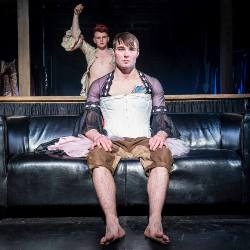Mother Clap's Molly House (Leicester Curve)
Leicester Curve and De Monfort University partner up to present Mark Ravenhill’s “play with music”

© REDPIX
Mark Ravenhill‘s Mother Clap’s Molly House at Curve Leicester, directed by Suba Das and presented in association with De Monfort University, is described as "a play with songs" and is a black comedy that examines gay male sexuality in London, both in 1726 and 2001.
The first act, set in 1726, shows a dressmaker who supplies the working girls of London but then quickly turns to the burgeoning gay subculture to start a "molly house", a safe-haven for gay men. The second act begins with a sex party in 2001, but the action then switches between the two time periods for the rest of the play.
The play demands a no-holds-barred approach, which for various reasons isn’t ever achieved. Uniformly the cast are extraordinarily rushed in both speech and action, as if confusing energy with haste. The speed and lack of variation of tone of delivery mean much nuance is lost.
What should be the play’s bread and butter is a comfort with sex and sexuality and, later, an everyday approach to drug taking. However, the sex displayed is toe-curlingly awful, the lust counterfeit, and the appearance of a ridiculously oversized bag of cocaine is laughed at, as the actors never really convince that they have seen drugs before, let alone taken them. Obscenities are delivered almost prudishly at times – each use of the C word is preceded by a little pause, as if the actor is bracing themselves.
There are highlights. [search]]Victoria Tye[[/search]], as Mother Clap, is strong throughout but is left with a number of drab scenes to carry by herself. Jade Pearce as Amelia is flirty, fun and foul-mouthed but underused. Paul Moore‘s set design is interesting and is used well to switch rapidly between time periods.
Other little things hamper the production. Curiously lazy anachronisms, like a dancer in 1726 having visible nipple piercings, doesn’t help suspension of disbelief. An odd placement of on-set microphones leads to jarring volume increases as an actor wanders within range during a speech. The show uses a mix of live and recorded sound which totally drowns out any attempts by cast to sing along and be heard.
Sadly, the production just never really gets going; less a riotous and wry celebration of sexual liberation than an overlong slog. It feels Millennial and dated in the points it labours to make: sex as a commodity and the perhaps false freedom of gay sexual liberation, the sadness of a loveless world rather lost amongst the waving of dildos.
– William Breden












